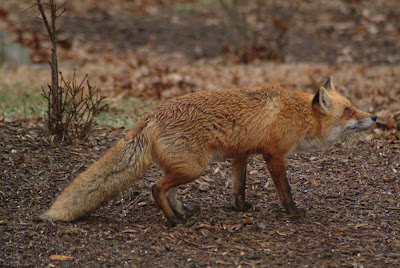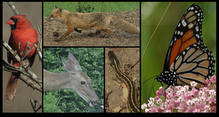Turkey Vultures



Wildlife observations from a suburban backyard adjacent to the Colvin Run Mill Park in Vienna, Virginia. Click on photos to enlarge.



Posted by
Gil Miller
at
12:01 AM
0
comments
![]()
Labels: Colvin Run Habitat, Vulture



Posted by
Gil Miller
at
7:13 PM
0
comments
![]()
Labels: Colvin Run Habitat, Eastern Gray Squirrel
The squirrels enjoy drinking water at the bird bath or at the water fountain. 
Many of the buried nuts that are not retrieved later germinate. The Habitat is full of many oak trees thanks to these little gray arborists. 
 The eastern gray squirrel mate and then give birth twice a year – in early spring and later summer. You can often see squirrels performing a mating "chase" where the male or males following a female as she moves about during the day.
The eastern gray squirrel mate and then give birth twice a year – in early spring and later summer. You can often see squirrels performing a mating "chase" where the male or males following a female as she moves about during the day.
Posted by
Gil Miller
at
7:02 PM
0
comments
![]()
Labels: Colvin Run Habitat, Eastern Gray Squirrel, Water
Sunday morning was wet, cold, and overcast and found the red-tailed fox stalking squirrels again. He made two observed runs and on both occasions had no success.


Posted by
Gil Miller
at
12:05 AM
0
comments
![]()
Labels: Colvin Run Habitat, Eastern Gray Squirrel, Red-tailed Fox
I wrote previously that I was concerned about a possible limp with the fox. If there was a limp, it was less noticeable on Sunday, than the previous day. With still photos it is extremely difficult to determine a limp. Regardless, here are two pairs of photos taken after his first and second run at the squirrels on Sunday morning.



Posted by
Gil Miller
at
12:03 AM
0
comments
![]()
Labels: Colvin Run Habitat, Red-tailed Fox
While looking for the fox from the upstairs window this morning, I noticed that there were no birds at the feeders – a sure sign that a hawk was in the Habitat. A quick look yielded no hawk. Opening the window, putting my head completely out the window, and turning left (north), I saw this hawk perched about 50 feet off the ground. 



Posted by
Gil Miller
at
12:05 AM
0
comments
![]()
Labels: Colvin Run Habitat, Cooper's hawk, hawk


The first two photos show the fox visually fixed on one of the squirrels as he made a run. The last photo is the fox patiently coming out of the brush, waiting for the right moment to charge the squirrels. This day, the fox was unsuccessful.
Posted by
Gil Miller
at
4:14 PM
0
comments
![]()
Labels: Colvin Run Habitat, Red-tailed Fox
Last Sunday, a pair of hawks visited the Colvin Run Habitat. It is not all that uncommon to have a pair of hawks flying over head (at several hundred feet in altitude), but Sunday was the first time that a pair was observed perched in the Habitat. 


Posted by
Gil Miller
at
7:00 PM
0
comments
![]()
Labels: Colvin Run Habitat, hawk, Red-Shouldered Hawk
Every once in a while, you get a day of surprises. Last Sunday was one such day. It started with the first snow of the winter season (yes, we have had a very warm winter and a mid-January first snow is a surprise). While the snow was light and we only received a dusting, photographing the male cardinal in the snow was a delight.


Posted by
Gil Miller
at
8:44 PM
0
comments
![]()
Labels: Colvin Run Habitat, hawk, Red-Shouldered Hawk
Saturday afternoon’s temperature in the Colvin Run Habitat barely reached freezing, but that did not stop the starlings from taking a bath. From the color of the water after they were done, it was a much needed bath. Click on the photo to get an enlarged photo and see the drops of water.
Why wasn’t the bath water frozen? I may have mentioned previously that earlier in the fall I received a bird bath warmer which keeps the water at just above freezing. Only the starlings take a bath. The other birds and the squirrels just drink the water.
Posted by
Gil Miller
at
5:17 PM
0
comments
![]()
Labels: Colvin Run Habitat, Starling, Water
One of the other feeders that I received as a Christmas present is this rather tall feeder in which I have put sunflower seeds. Because of its height, I have nicknamed it the Empire Seed Building (my oldest son used to live a block from this feeders namesake before he moved to the Greenwich Village and then Brooklyn Park Slope).
This new feeder is large enough to feed the resident birds for a full week. And, it is large enough that I can hang the smaller suet feeders from it. 
Many thanks to family and friends for this feeder – the birds say thanks as well.
Posted by
Gil Miller
at
12:05 AM
0
comments
![]()
Labels: Colvin Run Habitat, Downy Woodpecker, Feeder, Woodpecker
 I have previously written about the window feeder which gives a very close look at the birds. Initially, this window feeder was the sole domain of the smaller birds (chickadees and titmice). When the cardinals started using this feeder, we were well on the way to the larger birds.
I have previously written about the window feeder which gives a very close look at the birds. Initially, this window feeder was the sole domain of the smaller birds (chickadees and titmice). When the cardinals started using this feeder, we were well on the way to the larger birds. Today, the Blue Jay arrived. The feeder is barely large enough to accommodate him.
Today, the Blue Jay arrived. The feeder is barely large enough to accommodate him. Thought you might enjoy these blue jay photos. I especially like the first one where he is looking right at the camera.
Thought you might enjoy these blue jay photos. I especially like the first one where he is looking right at the camera.
Posted by
Gil Miller
at
12:01 PM
0
comments
![]()
Labels: Blue Jay, Colvin Run Habitat, Feeder
Various woodpeckers visit the the Colvin Run Habitat. Four documented types (from smallest to largest): Downy, Red-bellied, Flicker, Pileated. I have often suspected that we have had Hairy Woodpeckers at the feeders, but have never been quite sure. The main reason for the uncertainty is that the Downy and the Hairy differ in only two aspects – the Hairy is larger than the Downy and the Hairy as a proportionately larger bill. Other than that, the Downy and the Hairy look exactly alike.

Posted by
Gil Miller
at
11:39 AM
0
comments
![]()
Labels: Colvin Run Habitat, Downy Woodpecker, Hairy Woodpecker, Woodpecker
I received a few new feeders as Christmas presents. One of the most novel is this suet nut feeder. (remember to click on any photo to enlarge it)

Even when the woodpecker gets his turn, the nuthatch keeps a close eye on him.
Posted by
Gil Miller
at
8:00 PM
0
comments
![]()
Labels: Colvin Run Habitat, Downy Woodpecker, Feeder, Nuthatch

These three photos include a red-bellied woodpecker with an arriving starling. This woodpecker is slightly larger than the starling and usually moves other birds from the feeder if for no other reason than his size. In the first photo, you can see the woodpecker squawking even before the starling has landed. In the second, the woodpecker remains upset by the arrival of the starling. In the final photo, the woodpecker has yielded the suet feeder to the starling.
The funny thing is that these starlings are imported European birds released in New York City – if only they had stayed in Central Park: Conditioned by centuries of living in settled areas in Europe, this species easily adapted to American cities after 100 birds were liberated in Central Park, New York City, in 1890. Since then it has spread over most of the continent…Hordes of these birds create much noise, damage vegetable or fruit crops, and do considerable damage around feedlots, consuming and fouling the feed of domestic cattle, and have proved difficult to drive away. Starlings compete with native hole-nesters for woodpecker holes and natural cavities. (from eNature)
The eNature site also offers a story titled Bully Starlings Usually Win.
Posted by
Gil Miller
at
8:00 PM
0
comments
![]()
Labels: Colvin Run Habitat, Red-Bellied Woodpecker, Starling, Woodpecker
This is how the Cooper’s hawk takes his prey. He will fly over at tree-top level or lower. If there are birds at the feeder, he will fly at them and attempt to take one of them in flight. The more birds, the great the probability that the hawk catches one.
As shown in this first photo, the hawk will also perch in a tree overlooking the Habitat. If and when the birds appear at the feeder or roosting in the brush or trees (see the second photo – there are many cardinals and woodpeckers in this photo – hard for you and me to see them all (we have 20-20 vision), but remember the hawk has 2-20 vision which is 10 times more powerful than us), he swoops down looking for prey. Of course, when the birds see the hawk coming they dive deeper into the brush for cover.
However, many times as in the third photo, the hawk will perch in a tree branch that less than 15 feet off the ground. Then, he will simply follow the birds into the brush. In this third photo, the hawk is literally scouting the bushes before, it dives in. We have actually observed the Cooper’s hawk diving into the full azalea bushes or in the combination of trees and vines that are shown in the second photo. The birds will exit from the opposite side of the brush if they are fast enough.
Posted by
Gil Miller
at
12:23 AM
0
comments
![]()
Labels: Colvin Run Habitat, Cooper's hawk, hawk

This work is licensed under a Creative Commons Attribution-NonCommercial 3.0 License.
